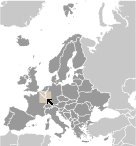World Atlas: Luxembourg. On this page you can see the map, country flag and many detailed information about the people, history and economy of Luxembourg.

Here you can find online selected information about the geography, inhabitants, government, economy and history of Luxembourg. Included are selected statistics, an overview map and the detailed map of Luxembourg. But let's start with the flag of Luxembourg here:
Luxembourg - Overview:
What you should know about Luxembourg? Let's start with this: Founded in 963, Luxembourg became a grand duchy in 1815 and an independent state under the Netherlands. It lost more than half of its territory to Belgium in 1839 but gained a larger measure of autonomy. In 1867, Luxembourg attained full independence under the condition that it promise perpetual neutrality. Overrun by Germany in both world wars, it ended its neutrality in 1948 when it entered into the Benelux Customs Union and when it joined NATO the following year. In 1957, Luxembourg became one of the six founding countries of the EEC (later the EU), and in 1999 it joined the euro currency zone.
Geography of Luxembourg
 Where on the globe is Luxembourg? The location of this country is Western Europe, between France and Germany. Total area of Luxembourg is 2,586 sq km, of which 2,586 sq km is land. So this is quite a small country. How could we describe the terrain of the country? This way: mostly gently rolling uplands with broad, shallow valleys; uplands to slightly mountainous in the north; steep slope down to Moselle flood plain in the southeast. The lowest point of Luxembourg is Moselle River 133 m, the highest point Buurgplaatz 559 m. And the climate is modified continental with mild winters, cool summers.
Where on the globe is Luxembourg? The location of this country is Western Europe, between France and Germany. Total area of Luxembourg is 2,586 sq km, of which 2,586 sq km is land. So this is quite a small country. How could we describe the terrain of the country? This way: mostly gently rolling uplands with broad, shallow valleys; uplands to slightly mountainous in the north; steep slope down to Moselle flood plain in the southeast. The lowest point of Luxembourg is Moselle River 133 m, the highest point Buurgplaatz 559 m. And the climate is modified continental with mild winters, cool summers.
Inhabitants of Luxembourg
Let's take a look how many people live in Luxembourg. The number is: 594,130 (July 2017 est.). So not so many people live here. Who lives here? Luxembourger 53.3%, Portuguese 16.2%, French 7.2%, Italian 3.5%, Belgian 3.4%, German 2.2%, British 1.1%, other 13.2%. What are the languages in Luxembourg? Luxembourgish (official administrative and judicial language and national language (spoken vernacular)) 55.8%, Portuguese 15.7%, French (official administrative, judicial, and legislative language) 12.1%, German (official administrative and judicial language) 3.1%, Italian 2.9%, English 2.1%, other 8.4% (2011 est.). And the religions: Christian (predominantly Roman Catholic) 70.4%, Muslim 2.3%, other (includes Buddhist, folk religions, Hindu, Jewish) 0.5%, none 26.8% (2010 est.). How old are the people in average? 39.3 years. We have to add that this number is the median - so one half of the people is older than this, one half is younger. And what is their life expectancy (at birth)? This: 82.3 years. Where the people live in Luxembourg? Here: most people live in the south, on or near the border with France. The major urban areas of Luxembourg are: Luxembourg (capital) 107,000 (2014).
Government and Economy of Luxembourg
The capital of Luxembourg is Luxembourg and the government type constitutional monarchy. Let's take a look at the administrative divisions - 12 cantons (cantons, singular - canton); Capellen, Clervaux, Diekirch, Echternach, Esch-sur-Alzette, Grevenmacher, Luxembourg, Mersch, Redange, Remich, Vianden, Wiltz. Regarding the economy of Luxembourg, important industrial products are banking and financial services, construction, real estate services, iron, metals, and steel, information technology, telecommunications, cargo transportation and logistics, chemicals, engineering, tires, glass, aluminum, tourism, biotechnology. Important agricultural products are grapes, barley, oats, potatoes, wheat, fruits; dairy and livestock products. The most important export commodities are machinery and equipment, steel products, chemicals, rubber products, glass and the most important export partners are Germany 23.1%, Belgium 16.6%, France 15.4%, Netherlands 5.1% (2016). The most important import commodities are commercial aircraft, minerals, chemicals, metals, foodstuffs, luxury consumer goods and the most important import partners are Belgium 29.4%, Germany 24.3%, France 10.3%, US 7%, China 5.8%, Netherlands 4.3%, Mexico 4.3% (2016). How rich is Luxembourg and how rich are people in this country? The most important number here is GDP per capita (PPP): $109,100 (2017 est.). So the people are extremely rich on average here. Let's add that this means Gross Domestic Product per person, which is recalculated with respect to the relative cost of local goods and services. And one more important number - population below poverty line: NA%.